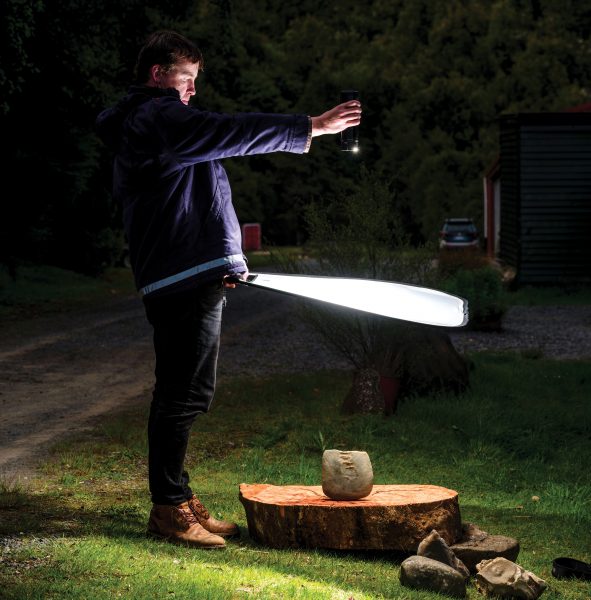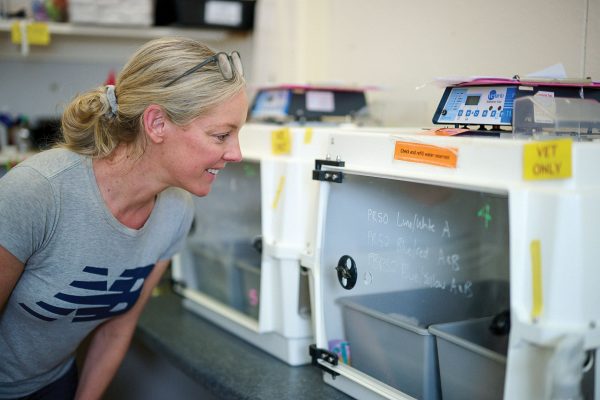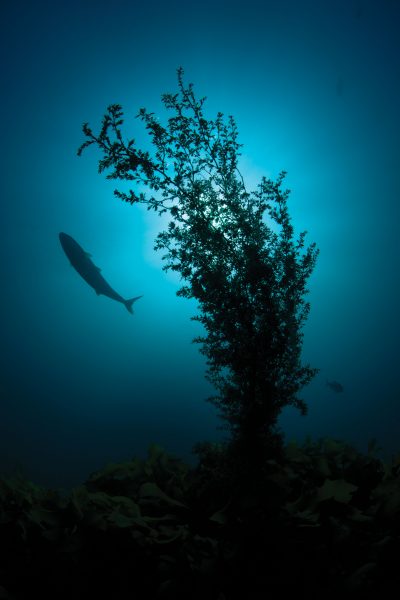SALUTE
As rain poured and gales swept the islands in the past several months, most of us crouched over our heaters. Meanwhile, New Zealand Geographic photographers Michael Schneider and Darryl Torckler were doing what they love best: respectively crawling through the bush looking for nocturnal insects, and floating underwater for hours at a stretch in a chilling 11 degrees. The results of their vigils can be seen in Schneider’s detailed photographs of glow-worms and Torckler’s stunning images from the magic underworld of Pupu Springs.
Most of Schneider’s photographs were shot in the Waitakere Ranges, west of Auckland, but one of the interesting facts which emerged while he and author John Walsby were searching for potential glow-worm sites was how many there were in the city itself, in parks and domains. In the end though, Schneider chose the Waitakere Ranges because he felt safer surrounded by the noises of the bush at night (and the cave wetas, spiders and giant centipedes) than by the late-night vagrants of a city.
Over a period of six weeks, as the rest of his household headed for bed, he would head for the lights of the bush. For hour after hour with the activity of the bush in full thrum around him and water dripping down his neck, Schneider waited to catch the key moments in a glow-worm’s life—when the female emerges from her pupa and mating occurs, or when an unsuspecting insect becomes glow-worm food as it entangles itself on the worm’s sticky beaded fishing line.
To avoid disturbing the worms unduly—and putting their lights out—Schneider worked with long exposures, “and I found that once my eyes adjusted I could work my camera by glow-worm light. It was bright enough to read my watch by.” Inevitably, in the course of his photo sessions, Schneider made many observations about glow-worm biology. He watched what they ate, and what ate them. And he found that if he stroked the pupae gently with a leaf, seven out of ten would turn their lights on. Perhaps not everyone’s idea of a good time, but Schneider’s results show his love for his subjects and the passion for wildlife photography which has now given him four cover photographs (land snails, tuatara, honey bees and spiders), and brought the subjects into our homes in extraordinary detail.
Schneider and underwater photographer Darryl Torckler have never met each other, but both share much in common. Both stepped into their chosen paths after being made redundant from “real” jobs; both decided to follow their photographic passions. Now, 20 years later, Torckler has won 58 international awards for his work, and has contributed images to New Zealand Geographic on the subjects of mangroves, crabs and Fiordland.
For this issue, Torckler remained underwater in Pupu Springs for up to four hours a day in water that never varies from 11.7°C. By the time he came up at the end of each one-and-a-halfhour stint, his face was so cold that his speech became blurred. But, like Schneider, Torckler doesn’t mind the hardship, so enthusiastic is he about his subject—in this case, the clearest underwater world in New Zealand.
“The water is so clear that when I was trying to take pictures of the salmon, they could see me 40 feet away. It was like being in a giant goldfish bowl.
“In the springs, it was like being in a Japanese garden of blues and greens. When I was down there I realised how fragile the environment is. The delicate weeds and mosses are adjusted to the flows of the vents which well up into the pools. If you knock the plants aside—so easy to do with fins—suddenly another jet blows them to pieces.”
As this issue went to press, Torckler was on his way to London to pick up yet another award for his work. Meanwhile, writer of the Pupu Springs story and co–writer of the d’Urville Island story in this issue, Gerard Hindmarsh was returning from Hong Kong after winning the Cathay Pacific travel writer of the year award for his story “Wilderness Coast” [Issue 14].
D’Urville Island has a special significance for Hindmarsh: his family, the Moletas, have been farming on northern d’Urville for nearly a hundred years. In 1902, his grandfather, Vincenzo Moleta, emigrated from Stromboli, in Italy, to join his brother who had started clearing land on the island a decade before.
Raised on the island, Hind-marsh’s mother Francesca spoke only Italian and Maori until the age of nine. But the isolation of the outer Sounds proved too intense for the passionate and once-gregarious Mediterraneans, and a family feud erupted, forcing a rift between branches of the family; his mother’s moved to the mainland.
Hindmarsh visited d’Urville for the first time in 1982, and gradually became the link between the two factions. Four years ago-50 years after she had left the island—Hindmarsh completed the circle and took Francesca back.

















